Growing sweet watermelons can be a delightful experience. Here’s a beginner’s guide to help you successfully cultivate sweet watermelons at home:
- Select the Right Variety:
- Choose a watermelon variety known for its sweetness. Popular sweet varieties include Sugar Baby, Crimson Sweet, and Sweet Beauty.
- Prepare the Soil:
- Watermelons prefer well-draining soil rich in organic matter. Ensure the soil has a slightly acidic to neutral pH.
- Choose a Sunny Location:
- Plant watermelons in a sunny spot with at least 8 hours of sunlight per day. Warm temperatures are essential for sweet fruit development.
- Planting Seeds or Seedlings:
- Directly sow watermelon seeds in the garden after the last frost date or start seeds indoors 2-4 weeks earlier.
- Alternatively, plant seedlings purchased from a nursery.
- Spacing:
- Allow sufficient space between plants (typically 3-5 feet apart) to ensure proper airflow and prevent overcrowding.
- Provide Support for Vining Varieties:
- If growing vining varieties, consider providing support for the developing fruit to prevent them from sitting directly on the ground.
- Watering:
- Watermelons require consistent moisture. Keep the soil consistently moist, especially during flowering and fruit development.
- Use drip irrigation or water at the base of the plants to avoid wetting the foliage.
- Fertilization:
- Apply a balanced fertilizer when planting, and provide additional fertilizer during the growing season following package instructions.
- Mulching:
- Mulch around the base of the plants to conserve moisture, suppress weeds, and regulate soil temperature.
- Pest and Disease Management:
- Monitor for pests like aphids and cucumber beetles. Consider using natural or organic pest control methods.
- Watch for signs of diseases like powdery mildew and treat accordingly.
- Pruning:
- Trim excess foliage to improve air circulation and sunlight exposure to the developing fruit. Prune selectively to avoid stress to the plant.
- Harvesting:
- Harvest watermelons when they develop a rich color, the underside turns creamy yellow, and the tendril closest to the fruit dries up.
- Gently lift the watermelon; if it feels heavy for its size and has a dull sheen, it’s likely ripe.
- Saving Seeds (Optional):
- If you want to save seeds for future planting, allow some watermelons to fully ripen, then collect and dry the seeds.
- Enjoy Your Sweet Harvest:
- Slice into the sweet, juicy watermelon and savor the fruits of your labor.
Growing sweet watermelons involves patience, proper care, and attention to the specific needs of the chosen variety. Happy gardening!

